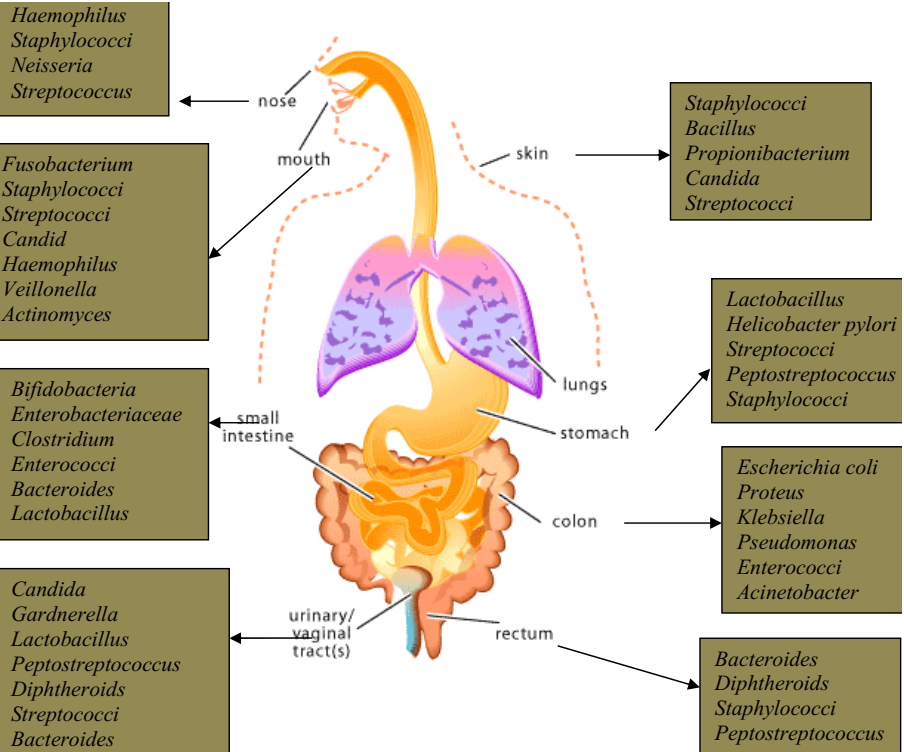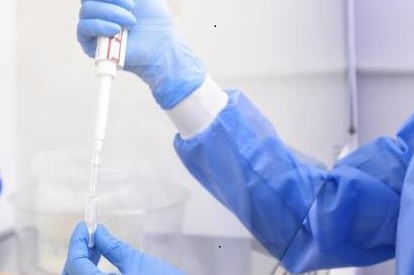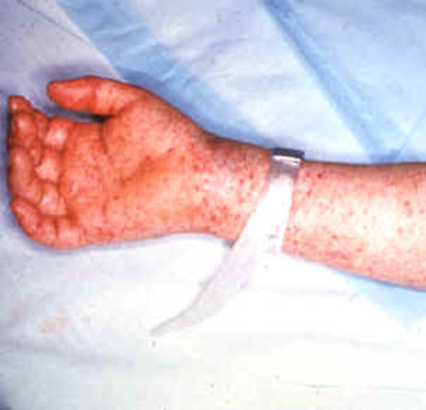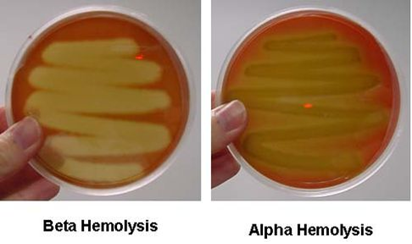Microbiota which can also be called normal microflora is the totality of microorganisms that are inherently present in a particular environment, body or location at every specific point of time. Mycoflora are fungal organisms that live in particular sites of the body without causing infection or disease. Microbiota goes into competition with pathogens on and in the human body with a view to subverting their pathogenic and virulent activities within the host. They do this through a process called amensalism (a bacterial interference mechanism).
In amensalism, normal microflora utilize available space, nutrients and other resources in the host (required by the pathogen to cause infection and disease) and produce substances that resist their disease-causing mechanisms in the host. Amensalism is an adverse microbe-microbe interaction in which the product or activity of one microorganism has a harmful effect on another microorganism. However, microbiota can turn form being harmless microorganisms to becoming potential pathogens to a host in some exceptional cases.
Others can also become opportunistic microorganisms which only cause disease in the host by chance i.e. when the environment or body of the individual favors their blossoming (e.g. in an immunocompromised case such as in an AIDS patients or an individual whose immune system has been suppressed due to therapy). The overuse of antibiotics, stress and nutritional imbalance in human beings can cause their microbiota to become pathogenic in nature. It should also be noted that different materials and substances (whether clinical or of non-clinical origin) have their own microflora which are well-known and very unique to them.
The microbiologist should acquaint him or herself on the basic knowledge of the different microbiota that make up different parts of the human body or the environment from which the samples they will be working with in the laboratory are actually made up of. This will allow the scientist to make concrete conclusions on the inferences drawn from a particular research or test so that the final judgment of an experiment is not based on the microbiota (which are not harmful and might not necessarily be the target or cause of the malady being deciphered).

The human body is well inundated with beneficial microorganisms which help to keep infectious organisms at bay; and these organisms (i.e. normal microflora) confer other health benefits to the individual (Figure 1). It is worth mentioning that the foetus in the womb of a pregnant woman (i.e. in utero) is free from normal microflora. Humans starts developing and forming their microbiota few seconds after delivery as microorganisms colonizes their external and internal body parts. Infants become colonized with a plethora of microorganisms and commensals which all constitutes their normal microflora; and this process of microbiota colonization in the infant commences soon after birth and this continues as the infant grows. Some internal tissues of a healthy human being including blood, brain, muscles and cerebrospinal fluid are normally germ-free i.e. they are free from microorganisms and are said to be sterile.
There are plethora of microorganisms in the intestinal tract of humans and other animals, and these organisms or normal floras play vital roles of protecting the intestines and its associated organs from invading pathogenic microorganisms. Some of the functions carried out by normal microflora in the gastrointestinal tract of humans include the repression of the growth of pathogens, digestion of unutilized energy substrates, stimulation of cell growth, and training of the immune system to respond only to pathogens. The entire gastrointestinal tract (GIT) of humans is usually sterile (i.e. free from microorganisms) at birth, but different types of microbes (both harmful and beneficial) start to colonize the human gut following the intake of food.
Over 500 different species of microorganisms are found in the human gut, and the type of microorganisms that colonize each sections of the gastrointestinal tract varies greatly with the type of food eaten. For example, Bifidobacterium is the most prevalent bacterium or normal flora that occupies the GIT of infants on breast milk. Bifidobacterium is later joined by other microbes including Enterobacteriaceae, Lactobacillus, Bacteroides, Clostridium and Enterococci following the weaning of the infants. These microbes (especially Bifidobacteria) are known as normal microflora of the intestinal tract, and they play vital roles in the GIT including prevention of the colonization of the gut by pathogenic microorganisms (Table 1).
In addition, these organisms also help to improve digestion and nutrition in their human host, and a handful of them such as Bifidobacteria are known to produce important vitamins (e.g. vitamin B12 and K) in the body. However, bacterial related diseases and even mycoses can ensue when the natural balance of the normal microflora in the body is tempered with especially via prolonged antibiotic usage, malnutrition and the contraction of some diseases such as AIDS (Table 1). The main parts of the human body naturally colonized by harmless microorganisms (i.e. normal microflora) and the diseases that can ensue in those parts when the normal body functioning is destabilized are summarized in Table 1.
Table 1. Some microbiota of the human body & their location
| MICROBIOTA | PART OF THE BODY FOUND | DISEASE |
| Pseudomonas, Enterobacteriaceae, coagulase-negative Staphylococci (CNS), Diphtheroids | Outer ear | Otitis media, sepsis, bacteraemia & diphtheria |
| Streptococcus, Propionibacterium, staphylococcus, Pseudomonas, Acinetobacter, Klebsiella, Enterobacter, Corynebacterium, Malassezia, Proteus, Pityrosporum, Candida | Skin | Bacteraemia, septicaemia, pneumonia, candidiasis |
| Enterococci, Mycobacterium, Actinomyces, Bacteroides, Peptostreptococci, Escherichia, Fusobacterium, Proteus, Klebsiella, Lactobacillus, Clostridium, Pseudomonas, Acinetobacter, Streptococcus, Staphylococcus, CNS | Large intestine | Staphylococcal & streptococcal infections, septicaemia, bacteraemia |
| Streptococci, CNS, Haemophilus, Staphylococci | Eye (conjunctiva) | Conjunctivitis, bacteraemia, pneumonia |
| Enterobacteriaceae, Lactobacilli, Clostridium, Enterococci, Mycobacterium, Bacteroides | Small intestine | Bacteraemia & sepsis |
| Streptococci, staphylococci, Eikenella, Candida, Veillonella, Streptococci Viridans, Fusobacterium, Neisseria, Corynebacterium, Treponema, Actinomyces, CNS, Prevotella, Haemophilus, Capnocytophaga, Lactobacilli, Geotrichum | Mouth and respiratory tract | Sore throat, sepsis, pneumonia, meningitis, candidiasis, & bacteraemia |
| Fusobacterium, CNS, Peptostreptococci, Streptococci, Bacteroides, Mycobacterium | Urethra | Urethritis & sepsis |
| Helicobacter, Streptococci, Enterobacteriaceae, Staphylococci, Lactobacillus, Peptostreptococci | Stomach | Septicaemia & bacteraemia |
| Neisseria, CNS, Haemophilus, Staphylococci, streptococci | Nose | Upper respiratory tract infection |
| Clostridium, Candida, Lactobacilli, Gardnerella, Diphtheroids, Bacteroides, Streptococci, Peptostreptococci | Vagina | Vaginitis, candidiasis & urethritis |
References
Black, J.G. (2008). Microbiology: Principles and Explorations (7th ed.). Hoboken, NJ: J. Wiley & Sons.
Brooks G.F., Butel J.S and Morse S.A (2004). Medical Microbiology, 23rd edition. McGraw Hill Publishers. USA.
Champoux J.J, Neidhardt F.C, Drew W.L and Plorde J.J (2004). Sherris Medical Microbiology: An Introduction to Infectious Diseases. 4th edition. McGraw Hill Companies Inc, USA.
Dictionary of Microbiology and Molecular Biology, 3rd Edition. Paul Singleton and Diana Sainsbury. 2006, John Wiley & Sons Ltd. Canada.
Engleberg N.C, DiRita V and Dermody T.S (2007). Schaechter’s Mechanisms of Microbial Disease. 4th ed. Lippincott Williams & Wilkins, Philadelphia, USA.
Gladwin M and Trattler B (2006). Clinical Microbiology Made Ridiculously Simple. 3rd edition. MedMaster, Inc., Miami, USA.
Levinson W (2010). Review of Medical Microbiology and Immunology. Twelfth edition. The McGraw-Hill Companies, USA.
Madigan M.T., Martinko J.M., Dunlap P.V and Clark D.P (2009). Brock Biology of Microorganisms, 12th edition. Pearson Benjamin Cummings Inc, USA. Pp. 902-903.
Mahon C. R, Lehman D.C and Manuselis G (2011). Textbook of Diagnostic Microbiology. Fourth edition. Saunders Publishers, USA.
Mandell G.L, Bennett J.E, Dolin R, eds. Mandell, Douglas, and Bennett’s Principles and Practice of Infectious Diseases, 5th ed. Philadelphia: Churchill Livingstone, 2002.
Murray P.R, Baron E.J, Jorgensen J.H., Pfaller M.A and Yolken R.H (2003). Manual of Clinical Microbiology. 8th edition. Volume 2. American Society of Microbiology (ASM) Press, Washington, D.C, U.S.A.
Murray P.R., Rosenthal K.S., Kobayashi G.S., Pfaller M. A. (2002). MedicalMicrobiology. 4th edition. Mosby Publishers, Chile.
Discover more from Microbiology Class
Subscribe to get the latest posts sent to your email.




